I. What are the Processes of Cell Senescence, Death, and Regeneration?
The saying “all good things must come to and end” can really be applied to really anything in our daily lives. Whether it’s the end of a memorable college experience, a football or basketball season, we always have to close one chapter in order to begin a new one (this is definitely true when getting through the MCAT content!
In a similar fashion, cells also have a finite lifespan and eventually have to meet their end; however, as some cells end their journeys, other cells are only just starting. In this article, we’ll go and cover some of the basic cellular mechanisms to how these processes occur and are maintained to ensure a homeostatic balance!
II. Processes of Cell Senescence, Death, and Regeneration
As mentioned above, all these cellular processes play a role in maintaining the cyclic lifespan of a typical cell. In addition, it’s also important that these processes are well regulated as dysregulation can cause uncontrolled cell proliferation which can eventually lead to cancer.
A. Cell Senescence
Most cells, especially stem cells, will undergo a great amount of cell division within their lifespans; however, at some point they reach a replicative limit, called a Hayflick limit, where they can no longer divide as any uncontrolled cell division can potentially lead to cancerous growth!
It’s at this point where the cell enters into a state called cell senescence where the cell can no longer divide and is simply going about its regular cellular processes; however, the cell does not die! To understand this, we have to review a little about DNA replication and chromosome structure.
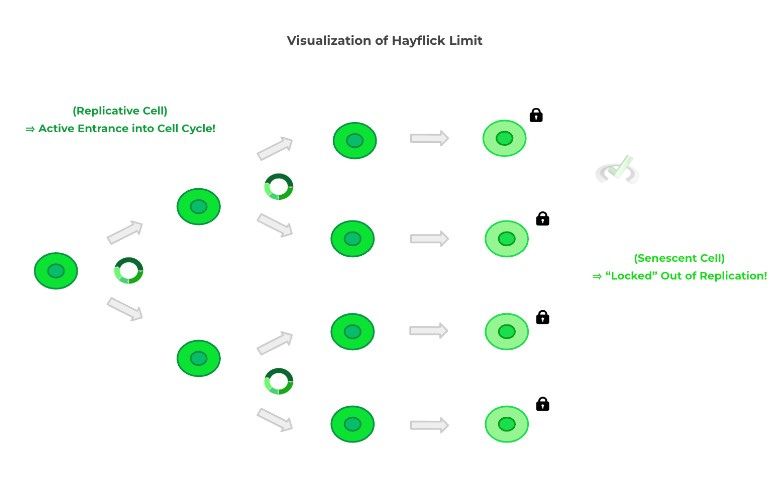
Telomeres are essentially “nucleotide caps” as they’re a repeating sequence of non-coding nucleotides at the end of the chromosome. Also recall that after every round of DNA replication, the DNA length shortens due to the lagging strand not being able to replicate a portion of its DNA!
Since telomeres are non-coding nucleotide sequences, they’re not at risk for any loss of genetic information after replication! However, after many cycles of replication, the telomeres become depleted and can no longer protect the important coded genetic information.
It’s at this point that further cell replication can possibly result in the loss of important genetic information — as such, the cell must enter into a state of cell senescence in order to prevent this loss!
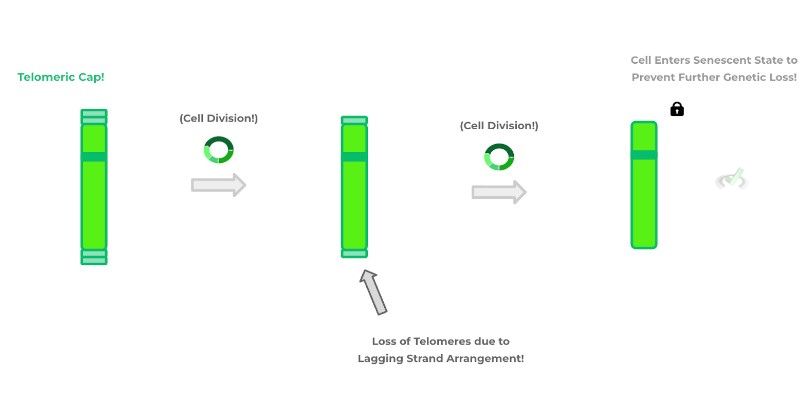
B. Cell Death
Though initially thought of as something negative, cell death is actually a crucial part of not just the cell cycle but also in ensuring the optimal health of the human body! One common, though unfortunate example is cancer where uncontrolled cell death leads to uncontrolled cell proliferation.
There are 2 main types of cell death that we’ll cover and are important in our health and physiology are necrosis and apoptosis which have distinct characteristics which are important to point out.
I. Necrosis
In its simplest form, necrosis is defined as cell death which is unprogrammed and is often due to external forces which initiates this unregulated cell death. Primarily think of anything which can cause cell injury such as bacterial infection, toxic substances like alcohol and tobacco, etc.
The main structural hallmark of cellular necrosis is cellular swelling due to decreased integrity of the cellular membrane! Swelling combined with cellular degradation results in cell death plus the leakage of cell contents into the extracellular space.
Because of their release, the cellular contents can initiate an inflammatory reaction which may be beneficial especially if the external injury is a pathogenic microorganism!

II. Apoptosis
Conversely, apoptosis is a programmed, regulated form of cell death that occurs in a more organized fashion. Usually, some of the main triggers of apoptosis are more internal such as the detection of DNA damage or old cell age.
Here, the main cellular feature of apoptosis is cell shrinkage due to dehydration as well as the formation of apoptotic bodies, which are essentially little vesicular remnants of the cell each of which contains cellular content.
Because the cellular contents are enclosed, an inflammatory reaction DOES NOT ensue! Rather, macrophages recognize the apoptotic bodies and phagocytose them to ensure that there’s an organized disposal of the cellular debris.
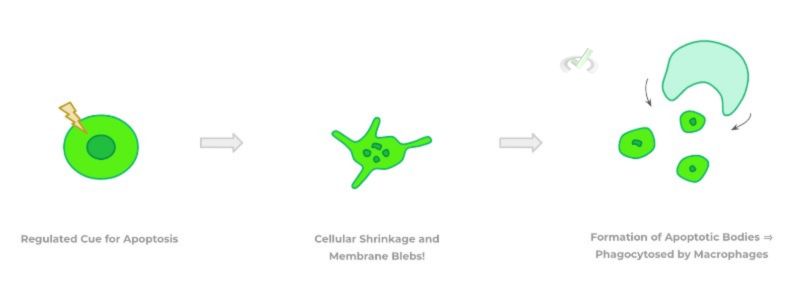
C. Cell Regeneration
Finally, although cells undergo death on a fairly regular basis, regeneration occurs in order to replace those cells which have died! Much of the regeneration potential of a certain cell type is dependent on the corresponding stem cell that gives rise to it.
For example, the keratinocytes of the stratum corneum undergo apoptosis and shedding on a regular basis — as such, these cells need a high regenerative capacity in order to replace the lost cells.
In order to replace the lost keratinocytes on the surface, the stem cells located on the stratum basale constantly proliferate and mature into new keratinocytes to allow for a constant turnover of cells!
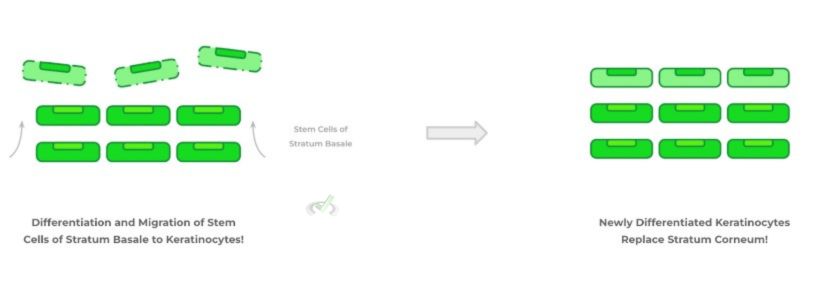
III. Bridge/Overlap
We talked about how telomere length and capping was an important factor in regards to both protecting the cell’s genetic information during replication as well as its role in inducing cellular senescence. Let’s go ahead and review the main structure and players that are involved in the formation of telomeres!
I. Review of Telomere Structure
As mentioned above, telomeres are a repeated nucleotide sequence of non-coding DNA which acts as caps on the chromosome in order to prevent loss of genetic information. Specifically, the telomeric sequence is 5’ - TTAGGG - 3’.
This sequence is encoded and produced by the enzyme telomerase which actually is a reverse transcriptase enzyme as it uses a RNA template to code the telomeric sequence!
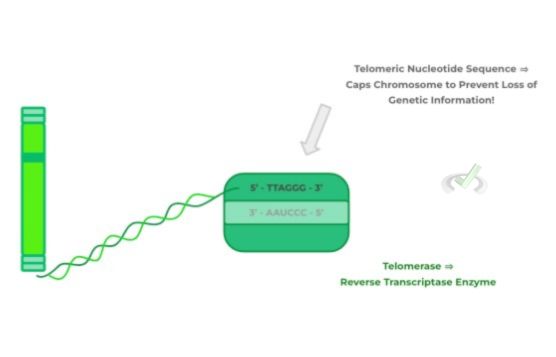
IV. Wrap Up/Key Terms
Let’s take this time to wrap up & concisely summarize what we covered above in the article!
A. Cell Senescence
When a cell enters its replicative capacity, called a Hayflick limit, they enter into a state called cell senescence where the cell is no longer actively dividing, but is simply going about its daily cellular function and process.
Much of this has to do with the structure of the chromosome, particularly the shortening of the telomeric caps.
Though the telomeres are at no risk of losing genetic information, once the telomeres are depleted, the cell must stop dividing and enter into cell senescence in order to prevent the loss of important genetic information!
B. Cell Death
There are 2 main types of cell death that occur: necrosis and apoptosis — these types of cell death have unique features particularly in the process towards how cell death occurs!
I. Necrosis
This form of cell death occurs due to external cell injury, such as infection or toxic substances, and is often described as an unorganized, nonprogrammed form of cell death.
The main features of necrotic cell death include cellular swelling due to loss of membrane integrity as well as cellular rupture which releases internal cellular content — because of this release, an inflammatory reaction can occur!
II. Apoptosis
This form of cell death is much more organized and programmed and primarily occurs due to more internal cell injury such as DNA damage or cellular aging.
Apoptotic cell death results in cellular shrinkage due to dehydration and results in the formation of apoptotic bodies, which are vesicular remnants of the apoptotic cell. Because cellular contents are not released, no inflammatory reaction occurs!
C. Cell Regeneration
Much of the regenerative capacity of a specific tissue is dependent on the stem cells that give rise to it! Some tissues, such as the skin, have a high regenerative capacity as the stem cells of the stratum basale are constantly replacing the lost keratinocytes on the stratum corneum!
V. Practice
Take a look at these practice questions to see and solidify your understanding!
Sample Practice Question 1
Telomerase is a type of reverse transcriptase enzyme responsible for the production of telomeres. In a cancer cell, how would you expect the expression of telomerase to change as well as the resulting cellular response?
A. Increased Expression, Decreased Cellular Senescence
B. Increased Expression, Increased Cellular Senescence
C. Decreased Expression, Decreased Cellular Senescence
D. Decreased Expression, Increased Cellular Senescence
Ans. A
Recall that cancer cells are abnormal cells which engage in prolonged, unregulated cellular replication. In this case, cancer cells would want to minimize entrance into cellular senescence.
As such, the expression of telomerase would increase in order to allow for the overproduction of telomeres. This would allow for no loss of important genetic information (because only the telomeres are being lost) and no entrance into cellular senescence!
Sample Practice Question 2
After examining a tissue sample, a pathologist notices cells that are dying. When he looks at the white blood cell count (WBC) on an analysis test, the WBC is normal. What type of cell death is occurring and what would the pathologist observe under the tissue specimen? (Hint: What would a normal WBC count indicate about the patient’s inflammation state?)
A. Necrosis, Cellular Swelling
B. Necrosis, Cellular Shrinkage
C. Apoptosis, Cellular Swelling
D. Apoptosis, Cellular Shrinkage
Ans. D
Recall that apoptosis is a more organized, programmed process for cell death which results in cellular shrinkage and the formation of apoptotic bodies.
Because the intracellular contents are never released, an inflammatory reaction does not occur which is why the WBC is normal. An elevated white blood cell count would be a sign and indicator of inflammation!







 To help you achieve your goal MCAT score, we take turns hosting these
To help you achieve your goal MCAT score, we take turns hosting these 





















 reviews on TrustPilot
reviews on TrustPilot